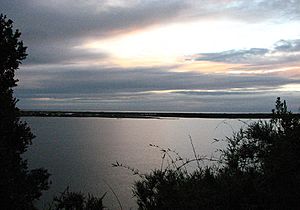Cucao and Huillinco facts for kids
Quick facts for kids Cucao and Huillicno LakeLago Cucao y Huillinco |
|
|---|---|

View of Cucao Lake
|
|
| Coordinates | 42°38′20.40″S 74°3′59.08″W / 42.6390000°S 74.0664111°W |
| Primary outflows | Cucao River, also called Desaguadero River |
| Basin countries | Chile |
| Surface area | 43.8 km2 (16.9 sq mi) |
The Cucao and Huillinco lakes are two connected lakes found in the middle of Chiloé Island in Chile. Even though they have different names, they are joined by a narrow waterway. This means they act like one big lake!
These lakes stretch from west to east across the island. They actually split the Chilean Coast Range into two smaller mountain ranges. To the north of the lakes is the Piuchén Range. To the south is the Pirulil Range. The water from these lakes flows out through the Cucao River, also known as the Desaguadero River. This river is at the western end of Cucao Lake and empties into the huge Pacific Ocean.
Contents
Where are the Cucao and Huillinco Lakes?
These interesting lakes are located on Chiloé Island. This island is part of the Los Lagos Region in southern Chile. It's known for its unique culture and beautiful nature.
How Big are the Lakes?
Together, the Cucao and Huillinco lakes cover an area of about 43.8 square kilometers. That's quite a large body of water!
Water Flow and Connection
The two lakes are connected by a natural channel. This channel allows water to move freely between them. This is why they are considered one "hydrologic" lake. It means they share the same water system.
The Cucao River: An Outlet to the Ocean
The water from the lakes eventually flows out through the Cucao River. This river is also called the Desaguadero River. It starts at the western side of Cucao Lake. From there, it travels a short distance before reaching the vast Pacific Ocean.
Surrounding Nature and Geography
The lakes are important because they divide the Chilean Coast Range on Chiloé Island. This creates two distinct mountain areas.
- Piuchén Range: This mountain range is located to the north of the lakes.
- Pirulil Range: This range can be found to the south of the lakes.
These natural features add to the beautiful landscape around Cucao and Huillinco lakes.
Learn More
In Spanish: Lago Cucao para niños


